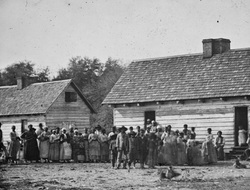 The simplified explanation of how black spirituals came about goes like this: slaves heard about Christianity after arriving in the US and, especially on the southern plantations, came up with sung versions of those teachings that gave them hope of a better life, expressed their longings for deliverance, and often served as rhythmic work songs. All of this is perfectly true but raises further questions: how did this “hearing about Christianity” come about? And why, if you think about it, would slaves adopt the religion of those who had enslaved them? Wouldn’t they see that religion as massive hypocrisy on the part of the slave owners? There’s also a tendency, which I have unfortunately shared, to think of spirituals as rather primitive. But that tendency is clearly mistaken: these are songs with deep meaning, displaying a breadth of Scriptural knowledge. To quote a modern African-American scholar and preacher, Thabiti Anyabwile, “Contrary to what might be supposed given the prohibition of education, reading and writing among slaves, early black Christians evidenced a rather sophisticated and clear theological corpus of thought.”
The simplified explanation of how black spirituals came about goes like this: slaves heard about Christianity after arriving in the US and, especially on the southern plantations, came up with sung versions of those teachings that gave them hope of a better life, expressed their longings for deliverance, and often served as rhythmic work songs. All of this is perfectly true but raises further questions: how did this “hearing about Christianity” come about? And why, if you think about it, would slaves adopt the religion of those who had enslaved them? Wouldn’t they see that religion as massive hypocrisy on the part of the slave owners? There’s also a tendency, which I have unfortunately shared, to think of spirituals as rather primitive. But that tendency is clearly mistaken: these are songs with deep meaning, displaying a breadth of Scriptural knowledge. To quote a modern African-American scholar and preacher, Thabiti Anyabwile, “Contrary to what might be supposed given the prohibition of education, reading and writing among slaves, early black Christians evidenced a rather sophisticated and clear theological corpus of thought.”
How, then, was this “corpus of thought” transmitted? Sometimes through forced attendance of slaves at plantation churches, where they were usually made to stand apart from their white masters and often had to listen to sermons that emphasized their responsibility to obey authority. It must have taken great perception on the part of these people to evaluate the truth of what they were hearing apart from the acts of those teaching it. But clearer and better teaching than that in those plantation churches would have come from Baptist and Methodist missionaries who were allowed to evangelize on some plantations and who taught that all Christians were equal in the sight of God, a message that was immensely appealing to slaves and equally threatening to their owners. There’s very little written history about how all this worked, but it seems pretty clear that there was quite a bit of variation in what was and was not allowed. A whole range of religious experiences could be available to slaves, with some services being held in secret and including traces of the African religions they had brought with them. Out of this mixture arose the spirituals.
Central doctrines of the Christian Gospel are clearly presented in many of these songs, in particular salvation by grace and the call to service. “Deep River,” “Ain’t Got Time to Die,” and “My God Is a Rock” all contain these truths. It is also true, though, that there is a double meaning in many spirituals. “My home is over Jordan” can refer to Heaven, but it can also refer to the earthly freedom that could be found in Canada. Some spirituals were actually banned on certain plantations because of their supposed seditious content; “Go Down, Moses” with its refrain of “Let my people go” was often forbidden. (If you know your Gone With the Wind, you’ll remember the scene in which Scarlett encounters some of the slaves from Tara who have been conscripted to dig trenches around Atlanta; she first realizes who they are because she recognizes the voice of Big Sam singing that very song. So Gerald O’Hara, Scarlett’s father and the owner of those slaves, apparently didn’t see a problem with it.) Other spirituals that, like “Go Down,” refer to stories/characters from the Old Testament, are “The Battle of Jericho,” “Ezekiel Saw De Wheel,” and “Elijah Rock.” (Scroll down to the end of the post linked to “Jericho” to read a little about it and see a great performance.)
Finally, can you call something composed after slavery ended a “true spiritual”? “Ain’t Got Time to Die” was apparently created, not just arranged, by Hall Johnson, a black composer and arranger who produced choral music during the first half of the 20th century and “who elevated the African-American spiritual to an art form.” He took the form of the spiritual very seriously, saying that “this music was transmitted to us through humble channels, but its source is that of all great art everywhere—the unquenchable, divinely human longing for a perfect realization of life.” (Both quotations are from Wikipedia.) I think we’d be willing to say that his composition is rooted in tradition enough so that it can be considered authentic. But what about modern compositions written in the style of a spiritual? “Mary Sat A-Rockin’” was written in 2003 by a middle-aged white guy, Greg Gilpin. I guess at some point you have to say that authenticity has to come from the intentions of the heart, both for the composer and for the performers. None of us in any choir singing today knows from personal experience what it’s like to be a slave—but we can still participate in this uniquely American music.

